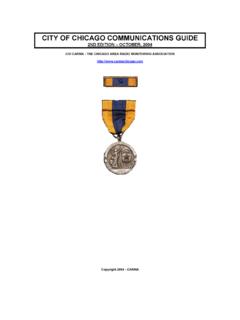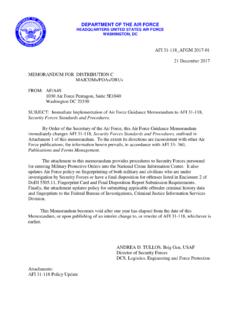Transcription of Trends and Practices in Law Enforcement and …
1 Department of JusticeOffice of Community Oriented Policing ServicesTrends and Practices in Law Enforcement and private security CollaborationsBy The Law Enforcement - private security ConsortiumOperation PartnershipTrends and Practices in Law Enforcement and private security CollaborationsT h is project was supported by Grant Number 2005-CK-WX-0454 awarded by the Office of Community Oriented Policing services , Department of Justice. The opinions contained herein are those of the authors and do not necessarily represent the official position of the Department of Justice.
2 References to specific agencies, companies, products, or services should not be considered an endorsement by the authors or the Department of Justice. Rather, the references are illustrations to supplement discussion of the Law Enforcement - private security Consortium was formed in 2005 to provide research, training, and technical assistance services that support development of effective law Enforcement - private security collaborations nationwide. Consortium members are the Institute for Law and Justice (ILJ), Hallcrest Systems, Inc.
3 , SECTA LLC, and Ohlhausen Research, Inc. ILJ administered the grant supporting the Consortium s production of this report and also administers a separate grant from the Office of Community Oriented Policing services that supports the Consortium s follow-up work to develop online training on law Enforcement - private security ..3 Chapter One: Introduction and Background ..5 Purpose of the Report ..5 Background: Operation Partnership ..7LE-PS Partnerships: Mandate, Benefits, and Challenges ..8 Chapter Two: Methodology ..25 Purpose of the Project.
4 26 Project Components and Tasks ..26 Chapter Three: Key Trends in Public- private Partnerships ..33 Introduction ..33 General Trends ..40 Trends Specifically Related to Homeland security ..46 Chapter Four: Forms of Partnerships ..51 Organizational Structure ..51 Specificity of Purpose ..55 Leadership Source ..56 Funding ..59 Membership ..60 Chapter Five: Types of Partnership Activities and Programs ..67 Information Sharing ..67 Training ..73 Crime Control and Loss Prevention ..75 Investigations ..78 Resource Sharing ..82 All-Hazards Preparation and Response.
5 83 Research, Policy Development, and Legislation ..85 Summary ..88 OPERATION PARTNERSHIP2 ACKNOWLEDGMENTSCOPS and Virginia Center for Policing Innovation video Law Enforcement and private security , On the Job Together companion CD located inside back Internet references cited in this publication were valid as of July 2009. Given that URLs and web sites are in constant flux, neither the authors nor the COPS Office guarantee their current validity. Chapter Six: Key Components of Law Enforcement - private security Partnerships.. 89 Compelling Mission ..89 External Support or Models for Formation.
6 92 Founders, Leaders, and Facilitators as Active Enablers ..93 Means of Communication ..103 Sustaining Structure and Resources ..105 Summary of Factors Leading to Success and Failure ..108 Chapter Seven: Conclusions and Future Steps ..109 Conclusions ..109 Future Steps ..111 Appendixes ..113 Appendix A: Fifteen Key Steps for Getting Started and Five Tips for Enhancing an Ongoing Law Enforcement - private security Partnership.. 114 Appendix B: Resources ..117 Appendix C: Selected Partnerships ..119 Appendix D: Additional Acknowledgments ..123 Appendix E: Executive Summary, COPS/IACP National Policy Summit: Building private security /Public Policing Partnerships to Prevent and Respond to Terrorism and Public Disorder.
7 126 Endnotes ..131 OPERATION PARTNERSHIPACKNOWLEDGMENTS3 ACKNOWLEDGMENTS This project received extensive support from Carl R. Peed, former Director of the Office of Community Oriented Policing services (the COPS Office); and Robert Chapman, COPS Office Supervisory Social Science are also grateful for the assistance provided by ASIS International and its Law Enforcement Liaison Council (LELC), and by the International Association of Chiefs of Police private Sector Liaison Committee (PSLC). Many LELC and PSLC members contributed information, suggestions, and encouragement.
8 Among those who provided support throughout the project are Randall Carroll, Former Co-Chair of the PSLC and retired Chief of Police, Bellingham (Washington) Police Department; Richard E. Chase, Chair of the LELC and Assistant Director and Chief security Officer, Bureau of Alcohol, Tobacco, Firearms and Explosives; Oksana Farber, LELC Vice Chair and President, Trident Master Executive Development; Michael Gambrill, LELC Member and Former Chair, Senior Vice President, Dunbar Armored security , and retired Chief of Police, Baltimore County (Maryland) Police Department; and Radford Jones of Michigan State University, who is Co-Chair of the PSLC.
9 In addition, we appreciate the support provided during this project by Gail M. Simonton, former National Association of security Companies (NASCO) Executive Director and General Counsel, LELC Member, and Associate Board Member of the International Association of security and Investigative also extend particular thanks to the project advisory group. In addition to Mr. Carroll and Mr. Gambrill (above), the project advisors were: Robert Lee, Principal Consultant, Mason-Coburn Partners, LELC Member and Former Chair, former Director, Justice Programs, Nextel Corporation, and former Supervisory Special Agent, Federal Bureau of Investigation; Lynn Oliver, President/CEO, American security Programs, Inc.
10 , and a founding member and Secretary, Virginia Police and private security Alliance, as well as a member of the Board of Directors, National Association of security Companies (NASCO); and Thomas Sweeney, Chief of Police, Glastonbury (Connecticut) Police Department and former Chief of Police, Bridgeport, addition, we sincerely appreciate ASIS International s assistance in disseminating the project s online survey to its membership. Special thanks go to ASIS International Executive Director Michael Stack, Director of Marketing Eileen Smith, and all ASIS members who responded to the PARTNERSHIP4 Project team members included the following: Institute for Law and Justice (Edward Connors, President, and Barbara Webster, Senior Writer/Principal Research Associate); Ohlhausen Research, Inc.









